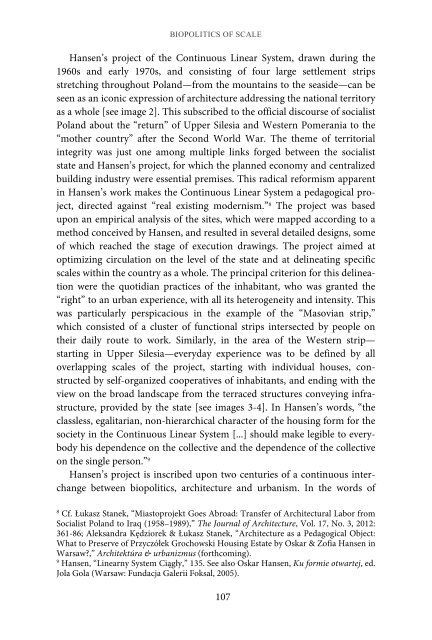Foucault, Biopolitics, and Governmentality
Foucault, Biopolitics, and Governmentality
Foucault, Biopolitics, and Governmentality
Create successful ePaper yourself
Turn your PDF publications into a flip-book with our unique Google optimized e-Paper software.
BIOPOLITICS OF SCALE<br />
Hansen’s project of the Continuous Linear System, drawn during the<br />
1960s <strong>and</strong> early 1970s, <strong>and</strong> consisting of four large settlement strips<br />
stretching throughout Pol<strong>and</strong>—from the mountains to the seaside—can be<br />
seen as an iconic expression of architecture addressing the national territory<br />
as a whole [see image 2]. This subscribed to the official discourse of socialist<br />
Pol<strong>and</strong> about the “return” of Upper Silesia <strong>and</strong> Western Pomerania to the<br />
“mother country” after the Second World War. The theme of territorial<br />
integrity was just one among multiple links forged between the socialist<br />
state <strong>and</strong> Hansen’s project, for which the planned economy <strong>and</strong> centralized<br />
building industry were essential premises. This radical reformism apparent<br />
in Hansen’s work makes the Continuous Linear System a pedagogical project,<br />
directed against “real existing modernism.” 8 The project was based<br />
upon an empirical analysis of the sites, which were mapped according to a<br />
method conceived by Hansen, <strong>and</strong> resulted in several detailed designs, some<br />
of which reached the stage of execution drawings. The project aimed at<br />
optimizing circulation on the level of the state <strong>and</strong> at delineating specific<br />
scales within the country as a whole. The principal criterion for this delineation<br />
were the quotidian practices of the inhabitant, who was granted the<br />
“right” to an urban experience, with all its heterogeneity <strong>and</strong> intensity. This<br />
was particularly perspicacious in the example of the “Masovian strip,”<br />
which consisted of a cluster of functional strips intersected by people on<br />
their daily route to work. Similarly, in the area of the Western strip—<br />
starting in Upper Silesia—everyday experience was to be defined by all<br />
overlapping scales of the project, starting with individual houses, constructed<br />
by self-organized cooperatives of inhabitants, <strong>and</strong> ending with the<br />
view on the broad l<strong>and</strong>scape from the terraced structures conveying infrastructure,<br />
provided by the state [see images 3-4]. In Hansen’s words, “the<br />
classless, egalitarian, non-hierarchical character of the housing form for the<br />
society in the Continuous Linear System [...] should make legible to everybody<br />
his dependence on the collective <strong>and</strong> the dependence of the collective<br />
on the single person.” 9<br />
Hansen’s project is inscribed upon two centuries of a continuous interchange<br />
between biopolitics, architecture <strong>and</strong> urbanism. In the words of<br />
8 Cf. Łukasz Stanek, “Miastoprojekt Goes Abroad: Transfer of Architectural Labor from<br />
Socialist Pol<strong>and</strong> to Iraq (1958–1989),” The Journal of Architecture, Vol. 17, No. 3, 2012:<br />
361-86; Aleks<strong>and</strong>ra Kędziorek & Łukasz Stanek, “Architecture as a Pedagogical Object:<br />
What to Preserve of Przyczółek Grochowski Housing Estate by Oskar & Zofia Hansen in<br />
Warsaw?,” Architektúra & urbanizmus (forthcoming).<br />
9 Hansen, “Linearny System Ciągły,” 135. See also Oskar Hansen, Ku formie otwartej, ed.<br />
Jola Gola (Warsaw: Fundacja Galerii Foksal, 2005).<br />
107


